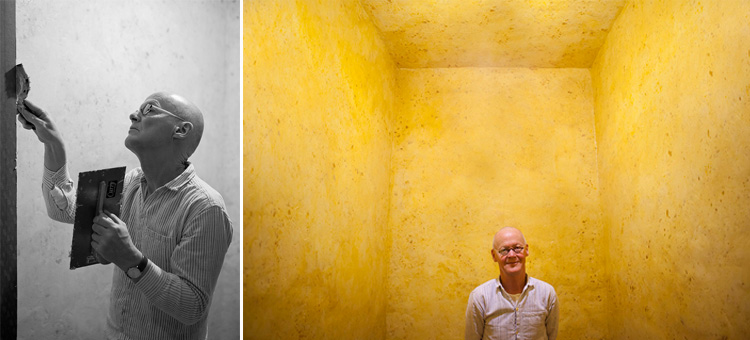In celebration of the Laib Wax Room‘s first anniversary as a permanent installation at The Phillips Collection, Membership Associate and Marketing & Communications Intern Rhiannon Newman, who was one of four assistants in the preparation and installation, describes her experience in a four part series.
The first time I saw Wolfgang Laib’s work was during a lecture somewhere in the art department of UC Santa Cruz. It was spring, and as the professor talked about Laib’s milkstones I remember the back door was open, and the heady scent of the rain dampened redwood forest drifted in on the breeze.
The first time I worked with beeswax was in a beginning sculpture class in college a week after I called my parents and said, “Fine, be angry with me for not getting a business degree, but I’m majoring in art because I want to be happy and create for the rest of my life.” I was in that state of euphoria that you can only feel when you’re young, absurdly confident, and think you know everything. As far as I was concerned, I had traded hours of revision and dreary, crowded lecture halls for making art all day in the open, airy studios nestled above an expansive meadow that overlooked Monterey Bay on campus. I was living my dream. Our professor had given us a small project to cast something in beeswax and showed us the old discarded crockpot that she used to melt it. I remember working on a project, lying on the ground looking up through the expansive skylight at the canopy of the redwood forest, smelling the beeswax melting across the room, and feeling incandescently happy.
Now Wolfgang Laib is not on a projector screen; he is standing in front of me and softly smiling in the catering kitchen of America’s first museum of modern and contemporary art. The dinky crockpot has been replaced by a state-of-the-art stainless steel double broiler that comes up above my knees. It’s not summer in Santa Cruz—it’s February in Washington, DC and freezing rain is pouring outside. Despite all of this, the heavy scent of beeswax and the profile of Laib’s face create a bizarre sense of déjà vu.
I brought my camera to document my experience for my own personal memories. Suddenly, Curator Klaus Ottmann asks me to photograph Wolfgang working. Then, the Director of Marketing and Communications asks if they could use my photographs for media. They want to submit my photos in press kits, for articles, for promotional materials and collateral, to The Wall Street Journal, and I can’t stop pinching myself. This is the definition of Maslow’s Peak Life Experience. This is better than a dream. I take the elevator up from where the assistants have been camped in the catering kitchen with my camera to where Wolfgang is working upstairs. It’s quiet, he’s silently plastering the wax on the walls, and I make a few photographs of him in the space. There is a small part of me that is absolutely terrified of the pressure to make portraits of a famous artist, a part of me that’s jubilant at the realization that all of these amazing opportunities are happening simultaneously, but I can only think one thing.
I am creating. I am happy. I will do this for the rest of my life.
Rhiannon Newman, Membership Associate and Marketing & Communications Intern

